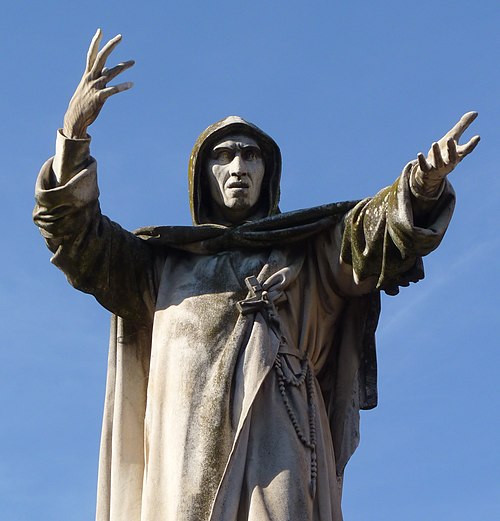
On May 23, 1498, the city of Florence in Italy witnessed a tragic event that left an indelible mark on the history of the Italian Renaissance. It was on this day that Jerome Savonarola, an Italian Dominican friar and religious reformer, was executed in the renowned Piazza della Signoria.
Jerome Savonarola was born in Ferrara, Italy, in 1452. From a young age, he devoted himself to religious life and joined the Dominican Order. His impassioned preaching and zeal for religious reform garnered him a growing reputation. In Florence, where he settled in 1482, he gained significant influence by preaching against the corruption of the Church and calling for a return to Christian piety and simplicity.
Savonarola quickly became a central figure in Florence, attracting large crowds with his fiery speeches and reformist ideas. He openly criticized the wealth and luxury of Florentine aristocratic families, as well as the immorality within the Church. His increasing popularity raised suspicions among the political and religious establishment.
However, events took a dramatic turn when Savonarola seized political control of Florence in 1494, following the expulsion of the Medici, the powerful ruling family of the city. He established a theocratic regime based on strict moral principles and promoted a series of radical reforms, including the establishment of a republican government.
Under Savonarola's rule, drastic measures were taken to purify the city. Books, artworks, and clothing deemed immoral were burned during the famous "Bonfire of the Vanities" held in the Piazza della Signoria. This symbolic act aimed to eliminate anything considered a source of moral corruption.
Nevertheless, Savonarola's popularity began to wane. His rigid reforms and authoritarianism sparked tensions and resistance, both in Florence and in Rome. Pope Alexander VI excommunicated Savonarola in 1497, and opposition grew within the city.
On May 23, 1498, after being arrested and tried for heresy, Jerome Savonarola was sentenced to death. In the Piazza della Signoria, where he had wielded power and delivered numerous speeches, he was executed by hanging. His supporters were also condemned and executed, marking the abrupt end of his reign and influence in Florence.
The death of Savonarola did not put an end to the debates and controversies surrounding his person and legacy. Some view him as a visionary reformer, while others criticize his methods and consider him a fanatic. Nevertheless, there is no denying the impact he had on the religious and political landscape of Florence during the late 15th century.
Today, the memory of Jerome Savonarola lingers in Florence, particularly in the Piazza della Signoria, where his execution took place. His story serves as a reminder of the complexities of religious and political movements, and the lasting effects they can have on a society's cultural and historical fabric.
Dudva, CC BY-SA 4.0, https://it.wikipedia.org/wiki/Girolamo_Savonarola#/media/File:Girolamo_Savonarola's_statue_in_Ferrara.jpg


0 comments: